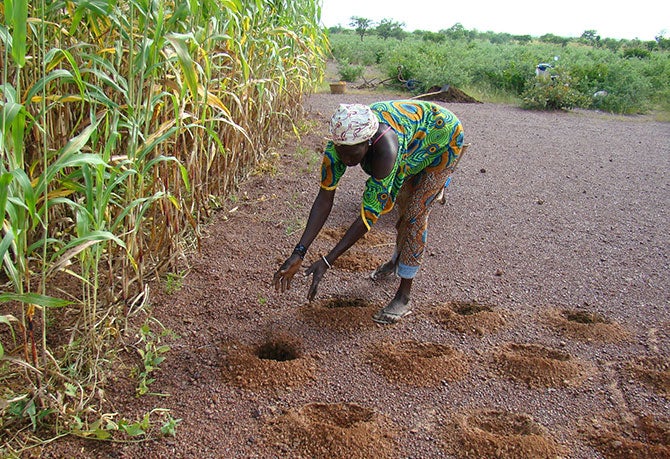
Launching on September 25, the Sustainable Development Goals (SDGs) will call for no less than an end to poverty, hunger and malnutrition by 2030. This is welcome news--and for the nearly 800 million people worldwide who will go to bed hungry-- long overdue.
To get there, it’s not just about raising yields. It’s also about managing risks to protect the most vulnerable. Along with gains in productivity, we also need more resilient agricultural systems. Failing this, unmanaged risks will upend the road to 2030. Climate change only ups the ante with promise of increasing weather extremes and new and more virulent pest and disease outbreaks.
Agriculture is risky business
By any measure, agriculture is risky business. It is also vital to ensuring food security and providing employment for 2.6 billion people worldwide, the vast majority of whom are subsistence farmers. Producing more than two-thirds of all food consumed worldwide on roughly half of the world’s arable land, these farmers also count among the poorest, the most vulnerable, the most food insecure on earth.
The challenge ahead is shifting from emergency response to investing in risk mitigation. To achieve the SDGs, developing countries will need help identifying areas where agricultural systems and rural livelihoods are most vulnerable; and where targeted investments in infrastructure, technical assistance, and policy support can help curb volatility and build ex ante resilience.
Targeted investments in risk mitigation can further the SDGs’ vision of productive, sustainable and resilient food systems that can feed everyone, every day, everywhere. Besides curbing shock-induced losses, these same investments can also help adapt systems and livelihoods to shifting climatic conditions. Among priorities, investments will drive adoption of drought tolerant crop varieties and livestock breeds. They will enhance access to irrigation and other technologies to maximize water, soil and land use efficiency. They will equip farmers with more timely and more accurate weather information to help them decide for themselves what, when and how to plant.
Prioritizing risks, targeting investments
The World Bank is spearheading a global initiative to promote a better understanding of agricultural risks, as well as effective pathways to improved risk management. In addition to enabling agriculture risk knowledge sharing through the FARMD platform, the Bank has worked with nearly 20 countries [1] to help agricultural stakeholders better comprehend the complexity of risks. This knowledge aids the selection of risk mitigation, transfer, and coping investments.
Based on this experience, the Bank has developed the Agricultural Sector Risk Assessment (ASRA), a conceptual framework that helps identify, measure and prioritize risk for improved targeting of risk management solutions. The analysis enables estimates regarding the frequency of historical risk events and the scale of attributed losses. These data points can assist governments, the private sector and other agricultural stakeholders to size up the costs of inaction and prioritize investments and policy choices that will strengthen resilience.
While the experience of conducting risk assessments depends on myriad factors and outcomes have varied across countries, there is broad recognition of ASRA’s usefulness as a practical tool for informed decision making. Outcomes from risk assessments have helped inform public policy and investments in a growing number of countries. In Niger, ASRA findings have helped shape the Government’s 10-year action plan for managing agriculture risks, and in Kenya, the Governments 2015-2030 program on Climate Smart Agriculture. In South America, ASRA helped define a core pillar of the Bank’s engagement with Paraguay, which focuses on strengthening agricultural resilience while reducing risk and volatility.
Toward shared goals
With climate change, the risky business of agriculture will only get riskier. By investing in ex ante risk mitigation and climate smart technologies, developing countries can kick-start the emergence of more productive, more resilient, and more sustainable food systems capable of feeding a population expected to top 9.5 billion people by 2050. Well aligned with its Twin Goals, the World Bank is committed to supporting these investments.
The benefits of improved agricultural risk management are multifold. Reducing production losses helps boost productivity. Curbing volatility can help protect rural jobs, incomes, and household food security. More diversified production systems and improved management of natural resources (e.g., soil, water, rangelands) can help strengthen biodiversity. By taming uncertainty, agricultural risk management also helps create a more predictable environment for investments and sustained sector growth.
Today, 1 in 9 people globally, or 1 of 4 in Africa, face a daily food deficit. This is often attributed to low fertilizer use rates, land degradation, restrictive trade policies, and other binding constraints. Too often overlooked are the debilitating impacts from unmanaged risks. Unless we invest more in stronger, more resilient agriculture, the number of hungry people in the world may well go up, not down. And that’s a risk we can’t afford to take.
The challenge ahead is shifting from emergency response to investing in risk mitigation. To achieve the SDGs, developing countries will need help identifying areas where agricultural systems and rural livelihoods are most vulnerable; and where targeted investments in infrastructure, technical assistance, and policy support can help curb volatility and build ex ante resilience.
Targeted investments in risk mitigation can further the SDGs’ vision of productive, sustainable and resilient food systems that can feed everyone, every day, everywhere. Besides curbing shock-induced losses, these same investments can also help adapt systems and livelihoods to shifting climatic conditions. Among priorities, investments will drive adoption of drought tolerant crop varieties and livestock breeds. They will enhance access to irrigation and other technologies to maximize water, soil and land use efficiency. They will equip farmers with more timely and more accurate weather information to help them decide for themselves what, when and how to plant.
Prioritizing risks, targeting investments
The World Bank is spearheading a global initiative to promote a better understanding of agricultural risks, as well as effective pathways to improved risk management. In addition to enabling agriculture risk knowledge sharing through the FARMD platform, the Bank has worked with nearly 20 countries [1] to help agricultural stakeholders better comprehend the complexity of risks. This knowledge aids the selection of risk mitigation, transfer, and coping investments.
Based on this experience, the Bank has developed the Agricultural Sector Risk Assessment (ASRA), a conceptual framework that helps identify, measure and prioritize risk for improved targeting of risk management solutions. The analysis enables estimates regarding the frequency of historical risk events and the scale of attributed losses. These data points can assist governments, the private sector and other agricultural stakeholders to size up the costs of inaction and prioritize investments and policy choices that will strengthen resilience.
While the experience of conducting risk assessments depends on myriad factors and outcomes have varied across countries, there is broad recognition of ASRA’s usefulness as a practical tool for informed decision making. Outcomes from risk assessments have helped inform public policy and investments in a growing number of countries. In Niger, ASRA findings have helped shape the Government’s 10-year action plan for managing agriculture risks, and in Kenya, the Governments 2015-2030 program on Climate Smart Agriculture. In South America, ASRA helped define a core pillar of the Bank’s engagement with Paraguay, which focuses on strengthening agricultural resilience while reducing risk and volatility.
Toward shared goals
With climate change, the risky business of agriculture will only get riskier. By investing in ex ante risk mitigation and climate smart technologies, developing countries can kick-start the emergence of more productive, more resilient, and more sustainable food systems capable of feeding a population expected to top 9.5 billion people by 2050. Well aligned with its Twin Goals, the World Bank is committed to supporting these investments.
The benefits of improved agricultural risk management are multifold. Reducing production losses helps boost productivity. Curbing volatility can help protect rural jobs, incomes, and household food security. More diversified production systems and improved management of natural resources (e.g., soil, water, rangelands) can help strengthen biodiversity. By taming uncertainty, agricultural risk management also helps create a more predictable environment for investments and sustained sector growth.
Today, 1 in 9 people globally, or 1 of 4 in Africa, face a daily food deficit. This is often attributed to low fertilizer use rates, land degradation, restrictive trade policies, and other binding constraints. Too often overlooked are the debilitating impacts from unmanaged risks. Unless we invest more in stronger, more resilient agriculture, the number of hungry people in the world may well go up, not down. And that’s a risk we can’t afford to take.
[1] These include Brazil, Haiti, Kenya, Ghana, Guyana, Kazakhstan, Kyrgyzstan, Malawi, Mongolia, Mozambique, Nicaragua, Niger, Paraguay, Rwanda, Senegal, Tajikistan, Tanzania, Uganda, and Vietnam.


Join the Conversation